|
Vandals destroy archaeological sites, artefacts:
Treasure hunting goes on unabated in remote areas
By K.K. Kariyakarawana
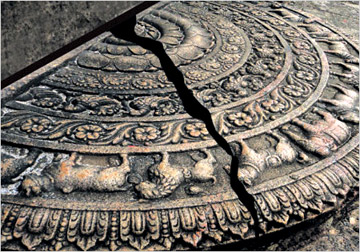
A cracked moonstone -treasure hunters had attempted to seek for
treasure beneath the moonstone |
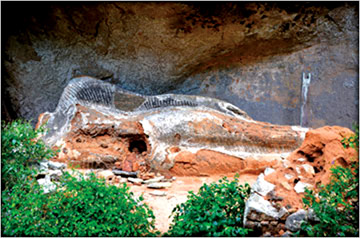
A Buddha statue was destroyed beyond recognition |
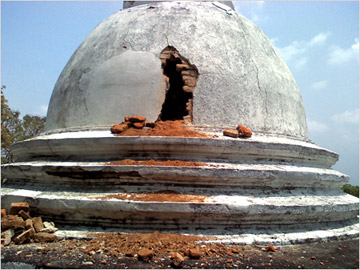
A stupa which was not spared by treasure vandals |
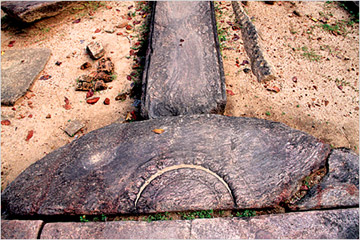 |
| An artefact
destroyed |
|
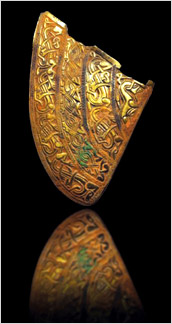
Another moonstone was partially destroyed
|
Treasure hunting or the craze for valuable antiques of a bygone era
is not uncommon in Sri Lanka. It has been happening for generations.
Hundreds of foreign invasions throughout the centuries proved that their
intentions were not only to gain power or prosperity for the country but
also to gain the wealth of a rich, archaeological history we owned.
Possessing various Ola leaves stating details of secret locations of
where treasures are hidden in remote areas or in dense jungles, various
rituals were being performed to propitiate guardian deities offering
even human sacrifices to obtain this wealth from time to time.
Armed
In Sri Lanka’s history, instances of treasure hunting was commonly
reported in the most remotest locations such as dense forests, barren
lands, in rocky caves or in ancient archaeological cities. Most of the
cases reported to the authorities have revealed that groups of people
armed with various tools, weapons, religious offerings, poultry animals
for sacrifices, Ola leaves, fruits and flowers were apprehended whilst
attempting to unearth buried treasure.
But this turned out to be a grave situation when a trend of damaging
and destroying archaeological sites and ancient artefacts in search of
treasure being hidden inside them was emerging during the past few
years. Instead of trying conventional methods of finding treasure, the
present trend was causing damage to artefacts like ancient statues,
stupas, stone inscriptions, guardian stones and ancient temples and was
being carried out in a frenzy suspecting that some treasures are hidden
inside them.
Responding to a query regarding the issue, Head of the Special Unit
for Prevention of Destruction and Theft Antiquities (SUPDTA) of the
Department of Archaeology, Udeni Wickramasinghe told the Sunday Observer
that there is a dangerous trend emerging these days where a number of
archaeological sites were targeted by treasure hunters.
Staggering
Statistics reveal that the number of cases of the destruction of
artefacts reported from 2008 has been increasing. Eighteen cases were
reported in 2008, 31 in 2009, 42 cases in 2010, 25 in 2011 and a
staggering 67 attempts were recorded in 2012. From January 1 to April 5,
22 cases had been reported for this year which is alarming
Wickramasinghe said.
The latest reports of the cases detected had shown that many people
believe that the treasures are being hidden inside artefacts which she
said is a myth. According to ancient reports there were no instance
where the treasures were hidden inside Buddha statues, stone
inscriptions, guard stones, moonstones or any other religious or
cultural establishments except for the fact that certain fortunes
belonged to kings and were said to be hidden in the base of Stupas and
statues.
State treasure
The concept of hidden treasure derived from local history where kings
hid state treasures in certain secret locations during the times of
foreign invasions. Bhikkus were in charge in ancient society of
valuables granted to temples and are said to be hidden in unpopular
locations during anarchies and invasions. These treasures were
reportedly hidden with the intention of recovering them in safer times.
A belief was there that a guardian deity popularly known as “Bahirawaya”
is in charge of the treasures hidden or buried and whoever who attempts
to seek them will not be successful and their lives were at risk.
Details of the places they were hidden and how to claim them back
without being subject to the anger of guardian deities were written on
Ola leaves by people who hid the treasures, according to the ancient
folklore. Attempts to sacrifice live offerings and even going to the
extent of sacrificing humans to appease the guardian deities have been
heard.
However, no proof had been found yet that any of these treasures were
hidden inside statues or artefacts. The Department of Archaeology is of
the view that the trend of destroying artefacts to hunt treasure was on
the rise following the liberation of Northern and Eastern lands after
the war.
Barred
The access to those areas had been barred by the LTTE for decades and
many archaeological sites had been preserved from treasure hunters for
years. Since 2009, the department had identified over 300 new
archaeologically important sites in Jaffna, Mulathivu, Mannar,
Kilinochchi and Vavuniya. The department has so far not been able to
look into sites found in Killinochchi and Vavuniya, whereas precautions
were taken to preserve other locations.
According to Ms. Wickramasinghe the people’s belief of existing
treasure is a myth. Over 180 foreign invasions had been reported in Sri
Lankan history and even though there were treasures, they would have
been robbed by foreigners a long time ago. Invaders from India in the
Anuradhapura and Polonnaruwa eras have taken large amounts of treasure
consisting of gold and precious stones back to their countries and
believed to be deposited in their temples and palaces. The damage caused
by uneducated men to destroy artefacts is a grave problem today where
vigilance and the law has to be tightened. Many incidents were reported
where the head and chest areas of Buddha statues were mercilessly carved
out by ignorant groups in search of treasure. Ancient stupas had been
levelled using bulldozers and on many occasions but no treasure had been
found in any instance. Some of the recent incidents were reported from
Athurupalayagama where an ancient stone inscription was damaged and the
Sagama Stupa in Motteyagala was levelled to the ground by a bulldozer.
[A new racket]
The Department of Archaeology is investigating a new racket where
certain groups have engaged in misleading the public by selling fake
artefacts for millions of rupees. The Special Unit for Prevention of
Destruction and Theft of Antiquities have identified several gangs
around the country who pose off to be expert treasure hunters and sell
fake artefacts to affluent people who harbour a secret desire to own
ancient artefacts, to elevate their statue. Investigations have revealed
that these gangs have deceived many businessmen and sold fake artefacts,
fake gems and gold that were claimed to have been recovered from
recently unearthed treasure. The suspected groups have even produced
models of artefacts and sold them to local crowds as well as to the
international market through smugglers who surreptitiously smuggle
themout.
Any suspicious incident or information could be reported to the
SUPDTA on hotline 0117222333 which is operational throughout the day and
night |


